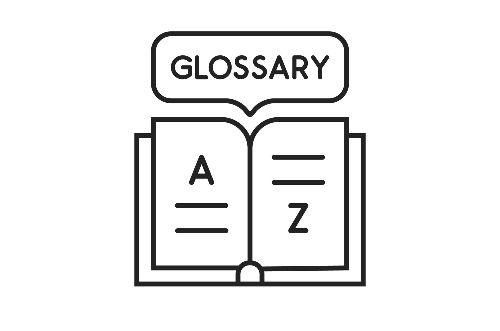New to the marketing world and need some help navigating the world of CTRs, CPMs, and SERPs? Or maybe you’ve been in the digital marketing game awhile but would like to brush up on your industry lingo. Whatever the case, we’ve compiled this handy dandy glossary that you can use as a reference so you can better understand your marketing reports and improve your digital marketing strategy!
Algorithms: A process by which information is stored, ordered, and retrieved in meaningful ways.
Alt Text: The text used to describe images on a web page. It is important to have alt text for SEO purposes, and it is also needed for ADA compliancy.
Backlinks: Links on other websites that direct people to your website.
Bid: The highest amount you’re willing to pay for a click on your ad.
Bots: What the programs that crawl the internet are referred to.
Bounce Rate: The percentage of visits that did not result in a second action being taken on your website. For example, if someone lands on your home page and then leaves without going to any other pages, this would be considered a bounce.
Caching: The saved version of each web page.
Click-Through-Rate (CTR): This measures the amount of people who clicked on your ad out of everyone who was served your ad.
Conversion: When a person completes a desired action as a result of clicking your ad. Common conversions are completing a purchase, making a phone call, or subscribing to an e-newsletter.
Cost Per Acquisition (CPA): A calculation of the total cost spent on an ad campaign divided by the amount of conversions that was received from the campaign.
Cost Per Click (CPC): The amount that a click on an ad costs an advertiser.
Crawling: Process of search engines discovering the contents of web pages.
Featured Snippets: Prominent, organic answer boxes that appear at the top of search engine results.
Google Analytics: A tool that allows website owners to analyze how people are interacting with their website. With Analytics, you can see where visitors are coming from, what pages they are visiting, how long they stay on your website, and more.
Google My Business Listing: Free listing through Google that is available to businesses.
Google Search Console: Free program for business owners from Google that allows for monitoring how a website is performing.
Google Tag Manager: System that allows you to easily update measurement codes known as tags on your website. Once a small segment of Tag Manager code has been added to your website, you can set up analytics and measurement tag configurations from a user-friendly interface.
Header Tags: HTML element that designates headings on a web page.
Impressions: The total number of times that an ad is shown.
Indexing: The organization of content that was found during the crawling process.
Internal Links: Links on your own website that direct to other pages on the same site.
Keyword: Words or phrases used in search engines to look for products, services, or information.
KPI: Stands for “key performance indicator”, which is a measurable value to show how well a campaign is achieving its goal.
Landing Page: The page on a website that a person reaches after clicking on an ad.
Local Queries: When a searcher is looking for services or products local to them, such as “restaurants near me” or “breweries in Rapid City”.
Long-Tail Keywords: Queries that contain more than three words.
Meta Descriptions: The snippets in search engine results that describes the contents of the pages of each entry.
Optimization: Adjusting aspects of an ad campaign in order to improve performance.
Organic: Non-paid placement in search results.
Pay-Per-Click (PPC): Used most often in SEM and paid search campaigns, it describes the way advertisers are billed for those types of campaigns.
Query: Words or phrases typed into the search bar of a search engine.
Ranking: The ordering of search results by how relevant they are to the query.
Referral Traffic: Traffic that is sent to a website from another website.
Responsive Design: Website design that allows the website to adapt to fit whatever device it is being viewed on.
Search Engine Marketing (SEM): Ad campaigns for search engines, which involve bidding on keywords in order for your ad to appear on the first page of results when the keyword is searched.
Search Engine Optimization (SEO): Non-paid, “organic” strategies used to improve results on a search engine results page.
Search Volume: Estimated amount of times a keyword or phrase is searched.
SERP: Stands for “search engine results page”, which is the page that is displayed after a search is conducted.
Sitemap: List of URLs on a website that crawlers use to index content.
SSL Certificate: Encrypts data between a web server and browser of the searcher to provide a secure connection.
Title Tag: Keywords that appear at the top tab of a website page and describes the content of that page.
Traffic: Visits to a website.
Target Audience: Group of people most likely to be interested in your products or services.
Targeting: Applying filters to a campaign, such as geography, age, or interests, in order to narrow down an audience to only the advertiser’s target audience.
UTM Code: A code that can be attached to the end of a URL to track details about the click, such as the name of the ad campaign that the click originated from.
Need additional help with your digital marketing? Contact the pros at Midwest Marketing! We can assist with all aspects of your marketing campaigns, including customized reporting that is easy to understand.

